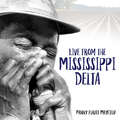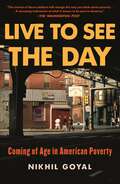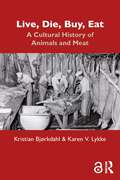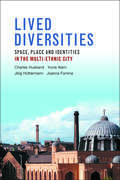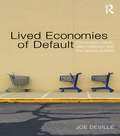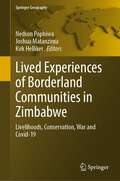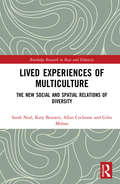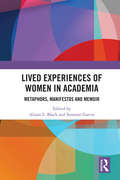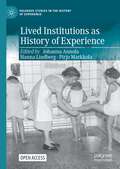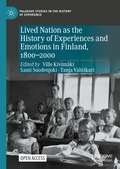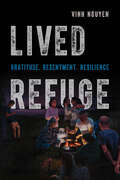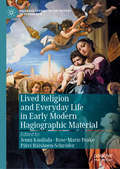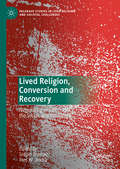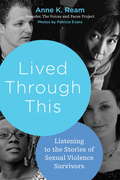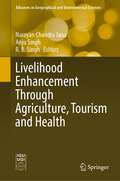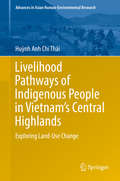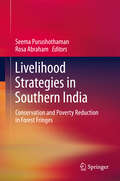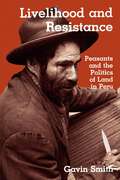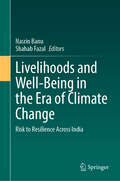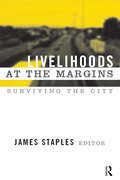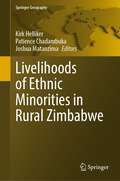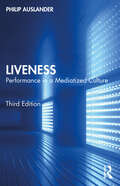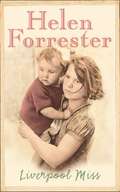- Table View
- List View
Live from the Mississippi Delta
by Panny Flautt MayfieldLive from the Mississippi Delta showcases a rare collection of photographs and stories about musicians from Robert Plant, B. B. King, and ZZ Top to local guitarists playing gigs on the weekend. Panny Flautt Mayfield, a lifelong Delta resident from Tutwiler and an award-winning journalist, documents multiple decades of blues and gospel music in her native land. Her first book collects over two hundred black-and-white and color photographs from a long career of photographing live music. Featuring text by Robert Plant in honor of Mayfield, the book opens with him addressing senior citizens gathered in Tutwiler to honor their town as the birthplace of blues. From there, the book proceeds throughout the Delta from juke joints and festivals to blues markers and museums. Mayfield presents images and tales of local icons such as Early Wright, Wade Walton, and the Jelly Roll Kings, as well as international celebrities. She shares intimate photos, including Garth Brooks and Bobby Rush charming elementary school kids in West Tallahatchie, along with insider stories and photos of B. B. King's Homecoming, the Governor's Awards, the Delta Blues Museum, the Sunflower and King Biscuit festivals, and a fascinating side trip to Norway's Notodden Blues Festival, which has a rich sister-city relationship with Clarksdale and the Sunflower Festival. Years ago volunteer tour guide Shirley Fair announced to visitors that there is a church or a juke joint on every corner in Clarksdale. Those demographics are still mostly accurate. Igniting a high-octane finale are photographs taken at iconic juke joints such as Smitty's Red Top, the Bobo Grocery, the Rivermount Lounge, Po' Monkey's, Hopson, Shelby's Dew Drop Inn, the Rose, Ground Zero, Sarah's Kitchen, Margaret's Blue Diamond, and Red's.
Live to See the Day: Coming of Age in American Poverty
by Nikhil GoyalAn indelible portrait of three children struggling to survive in the poorest neighborhood of the poorest large city in AmericaKensington, Philadelphia, is distinguished only by its poverty. It is home to Ryan, Giancarlos, and Emmanuel, three Puerto Rican children who live among the most marginalized families in the United States. This is the story of their coming-of-age, which is beset by violence—the violence of homelessness, hunger, incarceration, stray bullets, sexual and physical assault, the hypermasculine logic of the streets, and the drug trade. In Kensington, eighteenth birthdays are not rites of passage but statistical miracles.One mistake drives Ryan out of middle school and into the juvenile justice pipeline. For Emmanuel, his queerness means his mother’s rejection and sleeping in shelters. School closures and budget cuts inspire Giancarlos to lead walkouts, which get him kicked out of the system. Although all three are high school dropouts, they are on a quest to defy their fate and their neighborhood and get high school diplomas.In a triumph of empathy and drawing on nearly a decade of reporting, sociologist and policymaker Nikhil Goyal follows Ryan, Giancarlos, and Emmanuel on their mission, plunging deep into their lives as they strive to resist their designated place in the social hierarchy. In the process, Live to See the Day confronts a new age of American poverty, after the end of “welfare as we know it,” after “zero tolerance” in schools criminalized a generation of students, after the odds of making it out are ever slighter.
Live, Die, Buy, Eat: A Cultural History of Animals and Meat
by Kristian Bjørkdahl Karen V. LykkeLive, Die, Buy, Eat. These words represent a chain of events which today is disconnected. In the past few years, controversies around meat have arisen around industrialization and globalization of meat production, often pivoting around health, environmental issues, and animal welfare. Although meat increasingly figures as a problem, most consumers’ knowledge of animal husbandry and meat production is more absent than ever. Tracing a historical process of alienation along three distinct axes, the authors show how the animal origin of meat is covered up, rationalized, forgotten, excused, neglected, and denied. How is meat produced today, and where? How do we consume meat, and how have our consumption habits changed? Why have these changes occurred, and what are the social and cultural consequences of these changes? Using Norway as a case study, this book examines the dramatic changes in meat production and consumption over the last 150 years. With a wide range of historical sources, together with interviews and observation at farms, slaughterhouses, and production units, as well as analyses of contemporary texts and digital sources, Live, Die, Buy, Eat explores the transformation of animal husbandry, meat production and consumption, together with its cultural consequences. It will appeal to scholars of anthropology, sociology, cultural studies, geography, and history with an interest in food, agriculture, environment, and culture.
Lived Diversities: Space, Place and Identities in the Multi-Ethnic City
by Charles Husband Yunis AlamLived diversities: Space, place and identities in the multi-ethnic city is a timely and important book, which focuses on multi-ethnic interaction in an inner city area. Addressing difficult issues that are often simplistically and negatively portrayed it challenges the stereotypical denigration of inner city life, and Muslim communities in particular. Using well-crafted historical, political and contextual explanations the book provides a nuanced account of contemporary multi-ethnic coexistence. This invaluable contribution to our understanding of the politics and practice of multicultural coexistence is a must-read for students and practitioners interested in ethnic diversity, urban policy and the politics of place and space.
Lived Economies of Default: Consumer Credit, Debt Collection and the Capture of Affect (CRESC)
by Joe DevilleConsumer credit borrowing – using credit cards, store cards and personal loans – is an important and routine part of many of our lives. But what happens when these everyday forms of borrowing go ‘bad’, when people start to default on their loans and when they cannot, or will not, repay? It is this poorly understood, controversial, but central part of both the consumer credit industry and the lived experiences of an increasing number of people that this book explores. Drawing on research from the interior of the debt collections industry, as well as debtors' own accounts and historical research into technologies of lending and collection, it examines precisely how this ever more sophisticated, globally connected market functions. It focuses on the highly intimate techniques used to try and recoup defaulting debts from borrowers, as well as on the collection industry’s relationship with lenders. Joe Deville follows a journey of default, from debtors’ borrowing practices, to the intrusion of collections technologies into their homes and everyday lives, to the collections organisation, to attempts by debtors to seek outside help. In the process he shows how to understand this particular market, we need to understand the central role played within it by emotion and affect. By opening up for scrutiny an area of the economy which is often hidden from view, this book makes a major contribution both to understanding the relationship between emotion and calculation in markets and the role of consumer credit in our societies and economies. This book will be of interest to students, teachers and researchers in a range of fields, including sociology, anthropology, cultural studies, economics and social psychology.
Lived Experiences of Borderland Communities in Zimbabwe: Livelihoods, Conservation, War and Covid-19 (Springer Geography)
by Kirk Helliker Joshua Matanzima Nedson PophiwaThis book examines the national borders and borderlands of Zimbabwe through the presentation of empirically rich case studies. It delves into the lived experiences, both past and present, of populations residing along the borders between Zimbabwe and its neighbours, i.e., Zambia, Botswana, South Africa and Mozambique. It locates these lived experiences within the political economy of Zimbabwe, and highlights a wide range of themes pertinent to borders, including health, COVID-19, marginalisation, resource access, conservation, human-wildlife conflicts, civil wars, politico-economic crises, border jumping and cross border trade. The borderland communities discussed also include ethnic minorities such as the Tonga, San, Ndau, Shangane, and Kalanga. Overall, the book demonstrates the centrality of borders to the Zimbabwean nation-state and the importance of reading history, politics and society from the borderlands.The book fits into the wider prevailing literature of border and borderlands in Africa and beyond and thus has appeal far beyond Zimbabwe. Its diverse themes also relate to topics covered in multiple disciplines, including history, anthropology, and sociology. Academics, development specialists and policy makers will benefit in different ways from the depth and breadth of the analysis in the book.
Lived Experiences of Multiculture: The New Social and Spatial Relations of Diversity (Routledge Research in Race and Ethnicity)
by Giles Mohan Allan Cochrane Sarah Neal Katy BennettIn an increasingly ethnically diverse society, debates about migration, community, cultural difference and social interaction have never been more pressing. Drawing on the findings from a two-year, qualitative Economic and Social Research Council funded study of different locations across England, Lived Experiences of Multiculture uses interdisciplinary perspectives to examine the ways in which complex urban populations experience, negotiate, accommodate and resist cultural difference as they share a range of everyday social resources and public spaces. The authors present novel ways of re-thinking and developing concepts such as multiculture, community and conviviality, whilst also repositioning debates which focus on conflict models for understanding cultural differences. Amidst highly charged arguments over the social relations of belonging and the meanings of local and national identities, this timely volume will appeal to advanced undergraduate students and graduate students interested in fields such as Race and Ethnicity Studies, Sociology, Urban Studies, Human Geography and Migration Studies.
Lived Experiences of Women in Academia: Metaphors, Manifestos and Memoir
by Susanne Garvis Alison L. BlackLived Experiences of Women in Academia shares meaningful stories of women working in the academy, from numerous disciplines, backgrounds and countries, to unveil the complex and distinct dimensionalities they experience in their life and work. Chapters are written using a range of responsive, personal and aesthetic techniques, including metaphor, manifesto and memoir, with reflections inspired by textiles, online blogs and forums, theatre, creative writing, fiction and popular culture. They engage with themes and ideas including gender roles, family-making, work-life balance, motherhood, institutional violence and harassment and the self and identity, revealing how these uniquely manifest for women in academia. This collection takes account of the experiences of female academics from previous decades and the experiences of those to come, as well as those outside the academic system entirely. Lived Experiences of Women in Academia aims to liberate thinking around the life of a female academic through collaborative storytelling and discussion, to encourage new conversations and connections between women in academia across the globe
Lived Institutions as History of Experience (Palgrave Studies in the History of Experience)
by Johanna Annola Hanna Lindberg Pirjo MarkkolaThis open access book focuses on institutions that were produced and formed by the emerging welfare state. How were institutions experienced by the people who interacted with them? How did institutions as sites of experience shape and structure people’s everyday lives? Histories of institutions have mainly focused on the structures and power relations produced by institutional settings. Likewise, despite an extensive historiography of the welfare state, reflections on individuals’ experiences of welfare are few. By using ‘lived institutions’ as its conceptual frame, this edited collection merges the fields of institutional studies, the history of the welfare state – and the novel and vibrant field of the history of experience.
Lived Nation as the History of Experiences and Emotions in Finland, 1800-2000 (Palgrave Studies in the History of Experience)
by Tanja Vahtikari Ville Kivimäki Sami SuodenjokiThis open access book uses Finland in the nineteenth and twentieth centuries as an empirical case in order to study the emergence, shaping and renewal of a nation through histories of experience and emotions. It revolves around the following questions: What kinds of experiences have engendered national mobilization and feelings of national belonging? How have political and societal conflicts turned into new communities of experience and emotion? What kinds of experiences have been integrated into, or excluded from, the national context in different instances? How have people internalized or contested the nation as a context for their personal, family and minority-group experiences? In what ways has the nation entered and affected people’s intimate spheres of life? How have “national” experiences been transmitted to children in the renewal of the nation? This edited collection points to the histories of experience and emotions as a novel way of studying nations and nationalism. Building on current debates in nationalism studies, it offers a theoretical framework for analyzing the historical construction of “lived nations,” and introduces a number of new methodological approaches to understand the experiences of the nation, extending from the investigation of personal reminiscences and music records to the study of dreams and children’s drawings.
Lived Refuge: Gratitude, Resentment, Resilience (Critical Refugee Studies #5)
by Vinh NguyenA free ebook version of this title is available through Luminos, University of California Press’s Open Access publishing program. Visit www.luminosoa.org to learn more. In a world increasingly shaped by displacement and migration, refuge is both a coveted right and an elusive promise for millions. While conventionally understood as legal protection, it also transcends judicial definitions. In Lived Refuge, Vinh Nguyen reconceptualizes refuge as an ongoing affective experience and lived relation rather than a fixed category with legitimacy derived from the state. Focusing on Southeast Asian diasporas in the wake of the Vietnam War, Nguyen examines three affective experiences—gratitude, resentment, and resilience—to reveal the actively lived dimensions of refuge. Through multifaceted analyses of literary and cultural productions, Nguyen argues that the meaning of refuge emerges from how displaced people negotiate the kinds of safety and protection that are offered to (and withheld from) them. In so doing, he lays the framework for an original and compelling understanding of contemporary refugee subjectivity.
Lived Religion and Everyday Life in Early Modern Hagiographic Material (Palgrave Studies in the History of Experience)
by Jenni Kuuliala Rose-Marie Peake Päivi Räisänen-SchröderThis book discusses the ways in which early modern hagiographic sources can be used to study lived religion and everyday life from the fifteenth to the seventeenth century. For several decades, saints’ lives, other spiritual biographies, miracle narratives, canonisation processes, iconography, and dramas, have been widely utilised in studies on medieval religious practices and social history. This fruitful material has however been overlooked in studies of the early modern period, despite the fact that it witnessed an unprecedented growth in the volume of hagiographic material. The contributors to this volume address this, and illuminate how early modern hagiographic material can be used for the study of topics such as religious life, the social history of medicine, survival strategies, domestic violence, and the religious experience of slaves.
Lived Religion and Gender in Late Medieval and Early Modern Europe (Themes in Medieval and Early Modern History)
by Raisa Maria Toivo Sari Katajala-PeltomaaThis study is an exploration of lived religion and gender across the Reformation, from the 14th–18th centuries. Combining conceptual development with empirical history, the authors explore these two topics via themes of power, agency, work, family, sainthood and witchcraft. By advancing the theoretical category of ‘experience’, Lived Religion and Gender reveals multiple femininities and masculinities in the intersectional context of lived religion. The authors analyse specific case studies from both medieval and early modern sources, such as secular court records, to tell the stories of both individuals and large social groups. By exploring lived religion and gender on a range of social levels including the domestic sphere, public devotion and spirituality, this study explains how late medieval and early modern people performed both religion and gender in ways that were vastly different from what ideologists have prescribed. Lived Religion and Gender covers a wide geographical area in western Europe including Italy, Scandinavia and Finland, making this study an invaluable resource for scholars and students concerned with the history of religion, the history of gender, the history of the family, as well as medieval and early modern European history.
Lived Religion, Conversion and Recovery: Negotiating of Self, the Social, and the Sacred (Palgrave Studies in Lived Religion and Societal Challenges)
by Srdjan Sremac Ines W. JindraThe central theme of this book is the nexus between the self, the social, and the sacred in conversion and recovery. The contributions explore the complex interactions that occur between the person, the sacred, and various recovery situations, which can include prisons, substance abuse recovery settings and domestic violence shelters.With an interdisciplinary approach to the study of conversion, the collection provides an opportunity for a better understanding of lived religion, guilt, shame, hope, forgiveness, narrative identity reconstruction, religious coping, religious conversion and spiritual transformation. This volume will be of interest to scholars and students of lived religion, religious conversion, recovery, homelessness, and substance dependence.
Lived Through This
by Patricia Evans Anne K. ReamIn these pages you'll meet a community of rape and sexual violence survivors who have been shaped, but refuse to be defined, by their histories of violence. They are brave, and they are outspoken--but, mostly, they are hopeful. From its insistently resolute opening essay to its final, deeply moving story, Lived Through This is a book that defies conventional wisdom about life in the wake of sexual violence, while putting names and faces on an issue that too often leaves its victims silent and invisible. Part personal history of Anne Ream's own experience rebuilding her life after violence, part memoir of a multi-country, multi-year journey spent listening to survivors, Lived Through This is at once deeply personal and resolutely political. In these pages we are introduced to, among others, the women of Atenco, Mexico, victims of rape and political torture who are speaking out about gender-based violence in Latin America; Beth Adubato, a woman who was raped by a popular athlete and then denied justice when her college failed to fully investigate the attack; and Jenny and Steve Bush, a rape survivor and her father who are working together to share Jenny's testimony of surviving rape at the hands of a veteran in order to alter the US military's response to sexual violence committed by those in its ranks. Writing with compassion, candor, and, at times, even much-needed humor, Ream brings us a series of stories and essays that are as insistent as they are incisive. Considered individually, her profiles are profoundly moving, and even inspiring. Considered collectively, they are a window into a world where sexual violence is more commonplace than most of us imagine. The accomplished and courageous women and men profiled in Lived Through This are, in the words of the author, "living reminders of all that remains possible in the wake of the terrible."From the Hardcover edition.
Livelihood Enhancement Through Agriculture, Tourism and Health (Advances in Geographical and Environmental Sciences)
by R. B. Singh Narayan Chandra Jana Anju SinghAgriculture is the backbone of our economic system. It provides not only food and raw material but also employment opportunities to a very large number of people. Higher atmospheric temperature has an impact on crop yields while the changes in rainfall could affect both crop quality and quantity. Climate change, therefore, could increase the prices of major crops in some regions. For the most vulnerable people, lower agricultural output means lower income. In addition, climate change is expected to increase the risk of illness and death from extreme heat and poor air quality. Recent evidence is the COVID-19 pandemic. Furthermore, climate change also affects the occurrence of other infectious diseases. A number of well-known diseases are climate-sensitive - malaria, dengue fever, and cholera among others. Tourism is considered as an industry and alternative contributor to a nation’s income. It can generate employment opportunities and boost up the economy. This book, consisting of 26 chapters, focuses on the issues of agriculture, tourism and health for livelihood enhancement. It is essential to discuss these diverse issues in the field of geography as it encompasses interdisciplinary topics. The range of concerns at the national, regional and local levels is not confined to geography only but also involves other disciplines as well. Therefore, this book is a valuable source for scientists and researchers in allied fields such as livelihood, agriculture, land use, tourism management, health care and tribal studies. Furthermore, this book can be of immense help to the researchers, planners and decision makers engaged in solving problems in these areas in developing countries and beyond.
Livelihood Pathways of Indigenous People in Vietnam’s Central Highlands: Exploring Land-Use Change (Advances in Asian Human-Environmental Research)
by Huỳnh Anh Chi TháiThis study focuses on impacts of the environmental and socio-economic transformation on the indigenous people's livelihoods in Vietnam's Central Highlands recent decades since the country's reunification in 1975.The first empirical section sheds light on multiple external conditions (policy reforms, population trends, and market forces) exposed onto local people. The role of human and social capital is examined again in a specific livelihood of community-based tourism to testify the resilience level of local people when coping with constraints. The study concludes with an outlook on implications of development processed which still places agriculture at the primary position livelihood, and pays attention to human capital and social capital of indigenous groups in these highlands.
Livelihood Strategies in Southern India
by Seema Purushothaman Rosa AbrahamThis volume is a compilation of essays that focus on livelihood issues faced by forest communities of the southern Western Ghats region of India. Communities living along the fringes of forests are, more often than not, overlooked in academic and policy discussions. However, they face considerable pressures, being sandwiched between conservation endeavours and the forces of urbanization and commercialization. The chapters in this book provide an insight into the kinds of livelihood issues these communities face and the potential means that can be adopted to sustain these livelihoods. This volume provides a unique alternative perspective by locating livelihood issues within socio-ecological-economic narratives of communities living at the intersection of the three southern Indian states of Karnataka, Kerala and Tamil Nadu, and suggests directions for policies to address these challenges.
Livelihood and Resistance: Peasants and the Politics of Land in Peru
by Gavin SmithLivelihood and Resistance examines a Peruvian highland community where rural resistance has been endemic for over a century. Gavin Smith explores the way in which the villagers' daily economic interests and their political struggles contribute to their social and political identity.
Livelihoods and Well-Being in the Era of Climate Change: Risk to Resilience Across India
by Shahab Fazal Nasrin BanuThis volume addresses livelihood vulnerabilities due to climate change-induced socio-environmental stresses among different communities in various geographical locations in India, and discusses how the people and communities can become resilient to these stresses. Through multiple case studies and regional analyses, the authors provide a holistic understanding of the impacts of climate change on livelihoods and well-beings in India, where other works on the subject are often fragmentary and do not encompass a comprehensive presentation of these topics. This dedicated volume offers this comprehensive coverage, exploring how climate change impacts vulnerable communities, and how different actors such as vulnerable people, communities, governments, and NGOs are adopting strategies for resilience and sustainable livelihoods. As the impacts of climate change vary over geographical regions, the book targets a systematic coverage of the issue for different geographical regions in South Asia/ India, including the Himalayan region (Hilly Area), Indo-Gangetic Plain, Sundarbans (Mangroves), Coastal lands, Deccan Plateau, and Western Semi-arid and arid areas. The book is intended for social and environmental scientists, geographers, anthropologists, sociologists, regional planners, public administrators, and policymakers.
Livelihoods at the Margins: Surviving the City
by James StaplesSex workers, street hawkers, drug sellers, cleaners—they are people living on the margins of urban life who are ubiquitous but widely misunderstood and notably absent from mainstream economic analyses. In Livelihood on the Margins, anthropologists and practitioners engaged in hands-on development work use fine-grained ethnographic research to cut through the conventional narratives that romanticize, victimize, or demonize these populations. They go beyond the trendy “sustainable livelihoods” approach to development to examine the relationship between the agency people can actually wield over their own lives and the broader socio-political constraints that persistently push them to the margins. Making these multi-level connections across a wide range of world regions and situations, this volume shows how the micro-concerns of ordinary people might usefully guide the macro-concerns of governments, NGOs, and global institutions who are engineering large-scale social and economic development programs. Livelihood at the Margins is an engaging and eye-opening read for undergraduate and graduate students studying development in anthropology, sociology, geography, economics, and other disciplines, as well as a useful tool for developments studies researchers and practitioners.
Livelihoods of Ethnic Minorities in Rural Zimbabwe (Springer Geography)
by Kirk Helliker Patience Chadambuka Joshua MatanzimaThe book provides empirically-rich case studies of the lives and livelihoods of marginalised ethnic minorities in colonial and post-colonial Zimbabwe, with a specific focus on diverse rural areas. It demonstrates the dynamic and complex relationships existing between ethnic minorities and livelihoods, and analyses the ways in which projects of belonging (and identity-formation) amongst these ethnic minorities are entangled in their respective livelihood construction projects, and vice versa. The ethnic minorities include those considered indigenous to Zimbabwe, and those often defined as ‘aliens’, including ethnicities with a transnational presence in southern Africa. The ethnicities studied in the book include the following: Chewa, Doma, Tonga, Tshwa San, Shangane, Basotho, Ndau, Hlengwe and Nambya. By studying their livelihoods in particular, this book offers the first full manuscript about ethnic minorities in Zimbabwe. In doing so, it highlights the significance of these ethnic minorities to Zimbabwean history, politics and society.
Lively Cities: Reconfiguring Urban Ecology
by Maan BaruaA journey through unexplored spaces that foreground new ways of inhabiting the urban One of the fundamental dimensions of urbanization is its radical transformation of nature. Today domestic animals make up more than twice the biomass of people on the planet, and cities are replete with nonhuman life. Yet current accounts of the urban remain resolutely anthropocentric. Lively Cities departs from conventions of urban studies to argue that cities are lived achievements forged by a multitude of entities, drawing attention to a suite of beings—human and nonhuman—that make up the material politics of city making.From macaques and cattle in Delhi to the invasive parakeet colonies in London, Maan Barua examines the rhythms, paths, and agency of nonhumans across the city. He reconceptualizes several key themes in urban thought, including infrastructure, the built environment, design, habitation, and everyday practices of dwelling and provides a critical intervention in animal and urban studies. Generating fresh conversations between posthumanism, postcolonialism, and political economy, Barua reveals how human and nonhuman actors shape, integrate, subsume, and relate to urban space in fascinating ways.Through novel combinations of ethnography and ethology, and focusing on interlocutors that are not the usual suspects animating urban theory, Barua&’s work considers nonhuman lifeworlds and the differences they make in understanding urbanicity. Lively Cities is an agenda-setting intervention, ultimately proposing a new grammar of urban life.
Liveness: Performance in a Mediatized Culture
by Philip AuslanderLiveness: Performance in a Mediatized Culture addresses what may be the single most important question facing all kinds of performance today. What is the status of live performance in a culture dominated by mass media and digital technologies? Since its first appearance, Philip Auslander’s groundbreaking book has helped to reconfigure a new area of study. Looking at specific instances of live performance such as theatre, music, sport, and courtroom testimony, Liveness offers penetrating insights into media culture, suggesting that media technology has encroached on live events to the point where many are hardly live at all. In this new edition, the author thoroughly updates his provocative argument to take into account the impact of the internet, and cultural, social, and legal developments. He also addresses the situation of live performance during the COVID-19 pandemic. In tackling some of the last great shibboleths surrounding the high cultural status of the live event, this classic book will continue to shape opinion and to provoke lively debate on a crucial artistic dilemma: what is live performance and what can it mean to us now? This extensively revised, new edition of Liveness is an essential read for all students and scholars of performance-based courses.
Liverpool Miss
by Helen ForresterHelen Forrester grew up poor, as the eldest of seven children, there was never enough to eat. But her severe malnutrition wasn't her only challenge, her parents' wanted her to stay home and mind her siblings, instead of getting a job and earning her keep.
